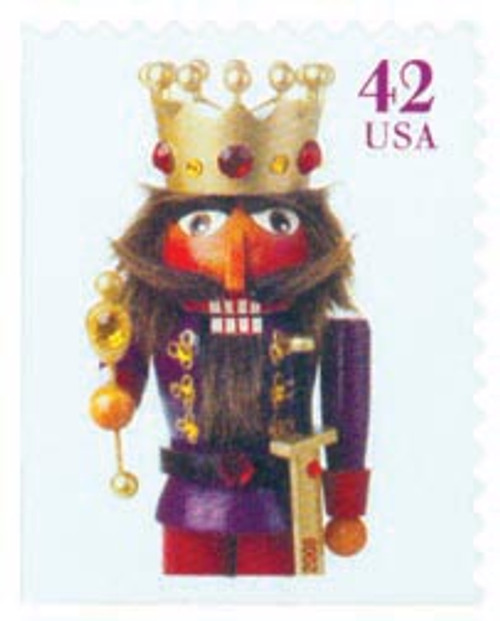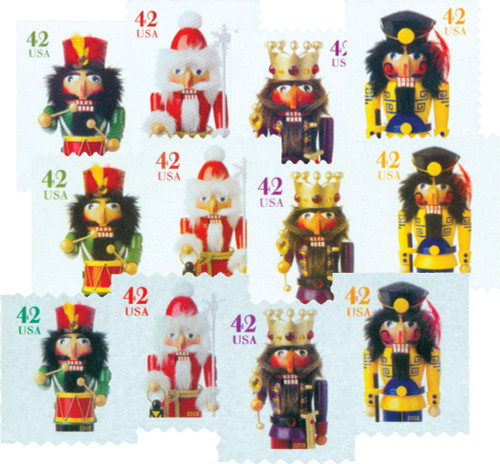
# 4360-63 FDC - 2008 42c Contemporary Christmas: Holiday Nutcrackers, convertible booklet
On December 18, 1892, Tchaikovsky’s The Nutcracker premiered in Saint Petersburg, Russia.
Germans coined the phrase, “Gott gibt die Nüsse, aber wir müssen sie knacken selbst.” (God gives the nuts, but we have to crack them ourselves). This verse is recited to teach German children that life is often difficult, but if you persevere the rewards are plentiful. This life lesson may have contributed to the popularity of nutcrackers, as it helped children to enjoy the benefits of hard work.

The Germans also have a folktale telling the origin of wooden nutcrackers. According to the story, a wealthy farmer was looking for an efficient way to crack the walnuts that grew on his tree. He decided to hold a contest for the local craftsmen to come up with a nut cracker. The local puppetmaker brought the farmer a brightly colored puppet with a large, strong jaw and won the contest. He was rewarded with his own workshop.
In reality, early nutcrackers existed centuries ago. Nuts were a popular dessert in Europe, and nutcrackers were placed on tables as a source of conversation as well as a way to open shells. By the 1800s, the Erzgebirge region of Germany had become well known for their nutcrackers. Many craftsmen made their living creating and selling them. Nutcrackers were often given as gifts, as they were thought to bring good luck to the home. Often shaped like soldiers, they protected the family from danger. The large mouth and teeth were thought to scare the evil spirits away.

Realizing the nutcracker’s importance to Germany, E.T. Amadeus Hoffman wrote the story, The Nutcracker and the Mouse King in 1816. Decades later, Russian composer Peter Tchaikovsky was tasked with producing a double-bill program for the Imperial Theatres. One performance would be his opera, Iolanta, and the other a ballet. Working with choreographer Marius Pepita, he decided to adapt Hoffman’s story into a ballet.
The Nutcracker premiered on December 18, 1892 to poor reviews. Much of the criticism was aimed at the dancers themselves and the extensive use of children in the ballet. But the response was much more positive for Tchaikovsky’s score. It was called “astonishingly rich in detailed inspiration” and “from beginning to end, beautiful, melodious, original, and characteristic.”

Due to its poor reception, The Nutcracker wasn’t performed again for many years. Then in 1919, Alexander Gorsky arranged a new version. He changed many of the problems identified during the premier performance, particularly by casting more adults. The Nutcracker was first performed outside of Russia in 1934 in England. The ballet then made its way to America in 1944.
The ballet’s popularity soared, particularly in the 1960s. Today, The Nutcracker is a Christmas season staple in America, viewed by millions every year.
On December 18, 1892, Tchaikovsky’s The Nutcracker premiered in Saint Petersburg, Russia.
Germans coined the phrase, “Gott gibt die Nüsse, aber wir müssen sie knacken selbst.” (God gives the nuts, but we have to crack them ourselves). This verse is recited to teach German children that life is often difficult, but if you persevere the rewards are plentiful. This life lesson may have contributed to the popularity of nutcrackers, as it helped children to enjoy the benefits of hard work.

The Germans also have a folktale telling the origin of wooden nutcrackers. According to the story, a wealthy farmer was looking for an efficient way to crack the walnuts that grew on his tree. He decided to hold a contest for the local craftsmen to come up with a nut cracker. The local puppetmaker brought the farmer a brightly colored puppet with a large, strong jaw and won the contest. He was rewarded with his own workshop.
In reality, early nutcrackers existed centuries ago. Nuts were a popular dessert in Europe, and nutcrackers were placed on tables as a source of conversation as well as a way to open shells. By the 1800s, the Erzgebirge region of Germany had become well known for their nutcrackers. Many craftsmen made their living creating and selling them. Nutcrackers were often given as gifts, as they were thought to bring good luck to the home. Often shaped like soldiers, they protected the family from danger. The large mouth and teeth were thought to scare the evil spirits away.

Realizing the nutcracker’s importance to Germany, E.T. Amadeus Hoffman wrote the story, The Nutcracker and the Mouse King in 1816. Decades later, Russian composer Peter Tchaikovsky was tasked with producing a double-bill program for the Imperial Theatres. One performance would be his opera, Iolanta, and the other a ballet. Working with choreographer Marius Pepita, he decided to adapt Hoffman’s story into a ballet.
The Nutcracker premiered on December 18, 1892 to poor reviews. Much of the criticism was aimed at the dancers themselves and the extensive use of children in the ballet. But the response was much more positive for Tchaikovsky’s score. It was called “astonishingly rich in detailed inspiration” and “from beginning to end, beautiful, melodious, original, and characteristic.”

Due to its poor reception, The Nutcracker wasn’t performed again for many years. Then in 1919, Alexander Gorsky arranged a new version. He changed many of the problems identified during the premier performance, particularly by casting more adults. The Nutcracker was first performed outside of Russia in 1934 in England. The ballet then made its way to America in 1944.
The ballet’s popularity soared, particularly in the 1960s. Today, The Nutcracker is a Christmas season staple in America, viewed by millions every year.














